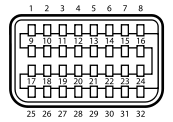Mini-DVI
|
The Mini-DVI plug on a 12-inch PowerBook G4 | |||
| Type | Digital and analog computer video connector | ||
|---|---|---|---|
| Production history | |||
| Designer | Apple Inc. | ||
| Manufacturer | Apple Inc. | ||
| Superseded | Mini-VGA | ||
| Superseded by | Mini DisplayPort (October 2008) | ||
| General specifications | |||
| External | yes | ||
| Video signal | As DVI | ||
| Pins | 32 | ||
| Pin out | |||
 | |||
| A female mini-DVI socket | |||
| Pin 1 | Dat2_P | Data 2 + | |
| Pin 2 | Dat2_N | Data 2 - | |
| Pin 3 | Dat1_P | Data 1 + | |
| Pin 4 | Dat1_N | Data 1 - | |
| Pin 5 | Dat0_P | Data 0 + | |
| Pin 6 | Dat0_N | Data 0 - | |
| Pin 7 | CLK_P | Clock + | |
| Pin 8 | CLK_N | Clock - | |
| Pin 9 | DGND | ||
| Pin 10 | DGND | ||
| Pin 11 | DGND | ||
| Pin 12 | DGND | ||
| Pin 13 | DGND | ||
| Pin 14 | DGND | ||
| Pin 15 | DGND | ||
| Pin 16 | DGND | ||
| Pin 17 | +5 V | ||
| Pin 18 | DCC_DAT | ||
| Pin 19 | spare | ||
| Pin 20 | BLUE | Analogue blue | |
| Pin 21 | not installed | ||
| Pin 22 | GREEN | Analogue green | |
| Pin 23 | not installed | ||
| Pin 24 | RED | Analogue red | |
| Pin 25 | Detect | ||
| Pin 26 | DCC_CLK | ||
| Pin 27 | spare | ||
| Pin 28 | DGND | ||
| Pin 29 | HSYNC | Horizontal sync | |
| Pin 30 | DGND | ||
| Pin 31 | VSYNC | Vertical sync | |
| Pin 32 | DGND | ||
The Mini-DVI connector is used on certain Apple computers as a digital alternative to the Mini-VGA connector. Its size is between the full-sized DVI and the tiny Micro-DVI. It is found on the 12-inch PowerBook G4 (except the original 12-inch 867 MHz PowerBook G4, it used Mini-VGA), Intel-based iMac, the MacBook Intel-based laptop, the Intel-based Xserve, the 2009 Mac mini, and some late model eMacs.
In October 2008, Apple announced the company was phasing Mini-DVI out in favor of Mini DisplayPort.
Mini-DVI connectors on Apple hardware are capable of carrying DVI, VGA, or TV signals through the use of adapters, detected with EDID (Extended display identification data) via DDC. This connector is often used in place of a DVI connector in order to save physical space on devices. Mini-DVI does not support dual-link connections and hence cannot support resolutions higher than 1920×1200 @60 Hz.
There are various types of Mini-DVI adapter:
- Apple Mini-DVI to VGA Adapter Apple part number M9320G/A
- Apple Mini-DVI to Video Adapter Apple part number M9319G/A, provided both S-Video and Composite video connectors (discontinued)
- Apple Mini-DVI to DVI Adapter (DVI-D) Apple part number M9321G/B (discontinued)
A non-OEM Mini-DVI to HDMI Adapter is also available on certain online stores such as eBay and Amazon, and from some retail stores, but not from Apple.
The physical connector is similar to Mini-VGA, but is differentiated by having four rows of pins arranged in two vertically stacked slots rather than the two rows of pins in the Mini-VGA.
Connecting to a DVI-I connector requires a Mini-DVI to DVI-D cable plus a DVI-D to DVI-I adapter.
Criticisms
- Apple's Mini-DVI to DVI-D cable does not carry the analog signal coming from the mini-DVI port on the Apple computer. This means that it is not possible to use this cable with an inexpensive DVI-to-VGA adapter for VGA output; Apple's mini-DVI to VGA cable must be used instead. This could be avoided if Apple provided a mini-DVI to DVI-I cable. The purpose of DVI-I is to ensure universal compatibility.[1][2]
- The Apple mini-DVI to DVI-D cable's package shows a DVI-I figure instead of DVI-D and does not specify that it comes with only DVI-D.
Compatibility
As Mini-DVI is pin-compatible with DVI, it supports both DVI and VGA through adapters.
See also
References
- ↑ "Blog explaining the difference". Retrieved 2009-10-11.
- ↑ "Image showing the difference". Retrieved 2009-10-11.
External links
| ||||||||||||||||||||||||||
